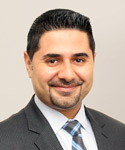 Technology is changing the face of medicine. Although cutting-edge research in such areas as artificial intelligence (AI) has not yet produced concrete applications specific to rheumatology, savvy practitioners are already envisioning the day it will.
Technology is changing the face of medicine. Although cutting-edge research in such areas as artificial intelligence (AI) has not yet produced concrete applications specific to rheumatology, savvy practitioners are already envisioning the day it will.
This group includes Suleman Bhana, MD, a rheumatologist and self-professed techie, who loves his Tesla Model S. He especially enjoys the autopilot mode, which makes the long commute to his offices easier to endure. On a recent drive, while listening to an audio version of an article about advances in bedside computer vision, the wheels in Dr. Bhana’s head started turning. If Tesla can build a semi-autonomous vehicle and researchers have shown AI can effectively classify skin-lesion images and interpret radiology scans (see below)—what AI opportunities are ahead for rheumatologists?
Right now, the question is unanswerable, but rheumatologists would do well to be ready for advances not yet thought of, says Dr. Bhana, who practices with Crystal Run Healthcare, Middletown, N.Y.
“Technology is all around us,” he says. “It’s a matter of integration, testing and getting it working. I think there are many inefficiencies in our system that we can undo with the proper use of technology.”
The NEJM article Dr. Bhana was listening to, “Bedside Computer Vision – Moving Artificial Intelligence from Driver Assistance to Patient Safety,” focused on the progress made in medical applications of AI during the past five years.1 Lead author Serena Yeung, PhD, a recent graduate of the Department of Computer Science and the Clinical Excellence Research Center at Stanford University, and her colleagues reported that AI was equal to 21 board-certified dermatologists in classifying digital images of benign and malignant skin lesions.2 She also points to smaller studies that demonstrated progress interpreting radiologic and pathological images, as well as machine interpretation of video data of clinician behaviors in operating rooms and ICUs, noting that AI is “poised to gain a foothold in screening medical images” and quantifying “progress in patients’ mobility.”3,4
“Right now, the bottleneck is really our understanding of all the applications AI can be used for,” Dr. Yeung says, noting algorithms are cost efficient and easy to maintain. “AI has huge potential, not only [for] disease diagnosis and treatment selection, but also in improving the day-to-day execution of care. This means once a treatment is decided, AI can assist with ensuring intended steps [are taken] in care, and [in] executing and improving personalized patient care plans.”
Practical Applications
Dr. Bhana, chair of the ACR’s Communications and Marketing Committee, has high hopes that technology will one day provide predictive pharmacology for his patients. In the short term, he is most excited about the prospect of AI relieving some of the administrative pressures weighing on his practice.
“More than 50% of my day has nothing to do with practicing medicine. That’s unfortunate and has a real impact on patients,” he says. “It also factors highly into physician burnout, so anything that can augment or automate the physician experience is really important.”
A good first step, he explains, would be automation in the areas of patient histories, notes and ordering labs, images and medications. Take, for example, the idea of a digital-assistant device—similar to an Amazon Echo or Google Home (if HIPAA approved, of course)—in an exam room with the patient and provider. The device, Dr. Bhana says, could listen in and act as a digital scribe, entering notes into the medical record and preparing X-ray orders or methotrexate refills.
“[Let the system] cue up the order, so all you have to do is review and approve,” he says, going one step further and likening this system to Amazon’s One-Click ordering. “That way, I can focus on a higher level task, such as what the heck is wrong with this patient and how can I treat them?”
Dr. Yeung agrees that technology will soon enhance clinicians’ ability to practice medicine more efficiently and “help reduce the incidence of errors.” She says rheumatology should explore AI integrations with in-home sensors and monitors to track and assess patient activity, diet, medication compliance, etc.
“For example, are patients showing signs of depression because they aren’t moving, aren’t looking out the window, aren’t eating, aren’t having social interactions?” she says. According to Dr. Yeung, these kinds of monitors are in place for chronic senior care and could be interesting for rheumatologists to consider.5
The Future
Dr. Bhana says he can see a not-too-distant future in which data, technology and the physician combine to move the needle on patient outcomes.
“It is a big data problem to tackle, but it is not an insurmountable problem,” Dr. Bhana says. “The Holy Grail for all of us in rheumatology is predictive pharmacology. What do we get from a data point of view that tells me ahead of time what the best therapy is for this patient? … I have patients who go through 10 different drugs before we find the one that works.”
Dr. Bhana acknowledges the future is uncharted and that the convergence of technology and medicine must be regulated, with patients and providers having “their equitable share of the data.”
“I share the cautious excitement of [Tesla founder] Elon Musk when it comes to AI: There is much to look forward to and much to be cautious about, particularly when it comes to proprietary information and private companies,” he says.
Richard Quinn is a freelance writer in New Jersey.
References
- Yeung S, Downing NL, Fei‑Fei L, Milstein A. Bedside computer vision—Moving artificial intelligence from driver assistance to patient safety. N Engl J Med. 2018;378(14):1271–1273.
- Esteva A, Kuprel B, Novoa RA, et al. Dermatologist-level classification of skin cancer with deep neural networks. Nature .2017 Feb 2;542(7639):115–118.
- Chen JH, Asch SM. Machine learning and prediction in medicine—Beyond the peak of inflated expectations. N Engl J Med. 2017 Jun 29;376(26):2507–2509.
- Haque A, Guo M, Alahi A, et al. Towards vision-based smart hospitals: A system for tracking and monitoring hand hygiene compliance. Proc Mach Learn Res. 2017;68:75–87 (https://arxiv.org/abs/1708.00163).
- Frangoul A. Artificial intelligence is helping to transform the way elderly people are cared for. CNBC. 2018 May 3.




